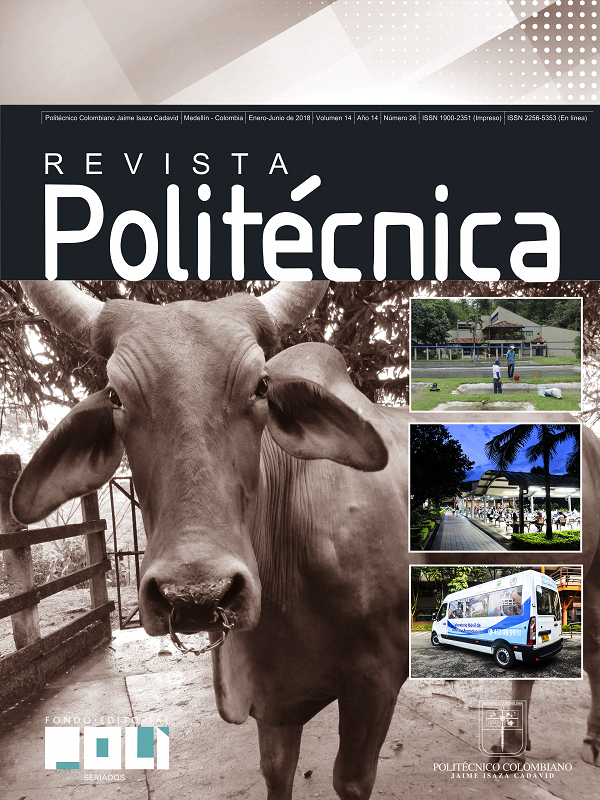Proposal of a procedure for automating an industrial process using Petri Nets as a formal tool
DOI:
https://doi.org/10.33571/rpolitec.v14n26a3Keywords:
automation project, formal methods, modeling, Petri nets.Abstract
Currently, industrial systems must adapt to changes in globalized markets in order to be competitive. In this context, automation is presented as a solution to ensure the efficiency and effectiveness of production. However, a correct specification of this kind of response is not a trivial task. This is due to the increase in the process dynamic complexity that involves personnel and technical resources of different nature as well as, risks derived from an incorrect solution definition. Thus, this article presents a structured process that considers the semantics of UML, Petri Nets as a modeling tools and automation standards to define the requirements, behavior and implementation of the system automation project. In order to assess the proposed approach, an application example was developed. Finally, the relevant contributions are stated in the context of the application.
Article Metrics
Abstract: 1106 HTML: 125 PDF: 428 XML: 36PlumX metrics
References
D. H. Autor, "Why Are There Still So Many Jobs? The History and Future of Workplace Automation," J. Econ. Perspect., vol. 29, no. 3, pp. 3–30, 2015.
D. T. Matt, E. Rauch, and P. Dallasega, "Trends towards distributed manufacturing systems and modern forms for their design," Procedia CIRP, vol. 33, pp. 185–190, 2015.
M. Rihar and G. Godena, "Automation of specification process for PLC control systemsnsoftware," 1999 7th IEEE Int. Conf. Emerg. Technol. Fact. Autom. Proc. ETFA ’99 (Cat. No.99TH8467), vol. 2, pp. 1289–1294, 1999.
M. Liukkonen, "RFID technology in manufacturing and supply chain," Int. J. Comput. Integr. Manuf., vol. 28, no. 8, pp. 861–880, 2015.
M. Hincapié, M. de Jesús Ramírez, A. Valenzuela, and J. A. Valdez, "Mixing real and virtual components in automated manufacturing systems using PLM tools," Int. J. Interact. Des. Manuf., vol. 8, no. 3, pp. 209–230, 2014.
R. Bayindir and Y. Cetinceviz, "A water pumping control system with a programmable logic controller (PLC) and industrial wireless modules for industrial plants-An experimental setup," ISA Trans., vol. 50, no. 2, pp. 321–328, 2011.
G. Frey, "Automatic implementation of Petri net based control algorithms on PLC," American Control Conference, 2000. Proceedings of the 2000, vol. 4. pp. 2819–2823 vol.4, 2000.
J. Luo, Q. Zhang, X. Chen, and M. Zhou, "Modeling and Race Detection of Ladder Diagrams via Ordinary Petri Nets," pp. 1–11, 2017.
M. Markiewicz and L. Gniewek, "A Program Model of Fuzzy Interpreted Petri Net to Control Discrete Event Systems," Appl. Sci., vol. 7, no. 4, p. 422, 2017.
L. Bryan and E. Bryan, "Chapter 10 The IEC 1131 Standard and Programming Language," in Programmable Controllers Theory Andimplementation, 2nd ed., Industrial Text Company, 1988.
P. Bonfatti, D. Monari, and U. Sampieri, IEC 1131-3 programming methodology. Software engineering methods for industrial automated systems. 1997.
T. Murata, "Petri nets: Properties, analysis and applications," Proc. IEEE, vol. 77, no. 4, pp. 541–580, Apr. 1989.
R. David and H. Alla, "Bases of Petri Nets," in Discrete, Continuous, and Hybrid Petri Nets SE - 1, Springer Berlin Heidelberg, 2010, pp. 1–20.
J. Dick, E. Hull, and K. Jackson, Requirements engineering. Springer, 2017.
J. Dick, E. Hull, and K. Jackson, "Requirements Engineering in the Problem Domain," in Requirements Engineering, Springer, 2017, pp. 113–134.
W. Chapman, Engineering modeling and design. Routledge, 2018.
L. E. G. Martins and T. Gorschek, "Requirements Engineering for Safety-Critical Systems: Overview and Challenges," IEEE Softw., vol. 34, no. 4, pp. 49–57, 2017.
J. S. Anderson and B. Durney, "Using scenarios in deficiency-driven requirements engineering," [1993] Proc. IEEE Int. Symp. Requir. Eng., pp. 134–141, 1992.
A. Arrieta, G. Sagardui, L. Etxeberria, and J. Zander, "Automatic generation of test system instances for configurable cyber-physical systems," Softw. Qual. J., vol. 25, no. 3, pp. 1041–1083, 2017.
P. H. Foo and G. W. Ng, "High-level Information Fusion : An Overview," J. Adv. Inf. Fusion, vol. 8, no. June, pp. 5–28, 2013.
"Use Case Diagram - UML 2 Diagrams - UML Modeling Tool." [Online]. Available: http://www.visual-paradigm.com/VPGallery/diagrams/UseCase.html#actor. [Accessed: 14-Jul-2014].
U. D. E. C. Station, "IDEF Family of Methods A Structured Approach to Enterprise Modeling & Analysis," Idef0 Method report, 2010. [Online]. Available: http://www.idef.com/. [Accessed: 20-Mar-2014].
A. A. V. Maobe, "System failure and perceived quality of services: a case of equity bank," 2014.
R. Sammi, I. Rubab, and M. A. Qureshi, "Formal specification languages for real-time systems," Proc. 2010 Int. Symp. Inf. Technol. - Syst. Dev. Appl. Knowl. Soc. ITSim’10, vol. 3, pp. 1642–1647, 2010.
G. Frey, "PLC Programming for Hybrid Systems via Signal Interpreted Petri Nets," Proc. 4th Int. Conf. Autom. Mix. Process. ADPM, pp. 189–194, 2000.
M. Ahmed, "A Comparative Analysis of Formal languages Based upon Various Parameters," vol. 3, no. February, pp. 434–438, 2016.
S. Rösch, S. Ulewicz, J. Provost, and B. Vogel-Heuser, "Review of Model-Based Testing Approaches in Production Automation and Adjacent Domains-Current Challenges and Research Gaps," J. Softw. Eng. Appl., vol. 8, no. 9, pp. 499–519, 2015.
P. Godefroid, Tests and Proofs, vol. 6706. 2011.
D. M. Uede and W. D. Miller, The engineering design of systems: models and methods. John Wiley & Sons, 2016.


 _
_






















